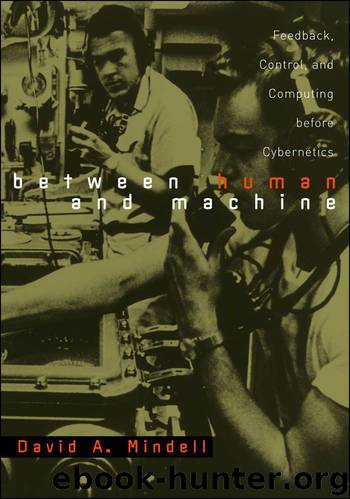Between Human and Machine: Feedback, Control, and Computing before Cybernetics (Johns Hopkins Studies in the History of Technology) by Mindell David A

Author:Mindell, David A. [Mindell, David A.]
Language: eng
Format: epub
Publisher: The Johns Hopkins University Press
Published: 2003-04-29T16:00:00+00:00
Fig. 7.2. Vannevar Bush’s “antiaircraft problem”: schematic of antiaircraft-system elements from a promotion for Western Electric’s M-9 electrical gun director ca. 1944.
Enemy plane (1) is spotted and followed by tracker (2) and height finder (3), which feed information into altitude converter (4) and computer (5). The computer plots the aircraft’s range, course, and speed and sends aiming directions to the gun (6), as well as a time for the shell to burst (7). The computer takes into account muzzle velocity of gun (A), shell drift due to spin (B), air density (C), time of shell’s flight (D), gravity (E), wind (F), and parallax between tracker and gun (G).
“One must always remember that a fire-control system is more than the sum of component parts,” wrote Harold Hazen at the end of the war. “It is an integrated whole with interrelated functioning of all its parts and one is safe in considering the parts separately only if one always keeps in mind their relation to the whole.” 55 Before the war an engineering vision of control as a general principle had just begun to take shape, and the NDRC completed the formulation by concentrating on each element in the system and then on their integration .
When the NDRC began operations, Sperry Gyroscope and others had already defined the components of antiaircraft fire control (Fig. 7.2 ). Instruments of perception, in the form of optical rangefinders and tracking telescopes, provided range, bearing, and elevation of the target. As the war progressed, radar took over these functions, at first only for rangefinding and later for tracking. A central computer or gun director integrated these data with settings for wind, terrain, and ballistics, which depended on the particular gun and shell. The director predicted the future location of the target based on its speed and direction and calculated azimuth, elevation, and fuze setting. These data were articulated to the guns, which pointed automatically, with hydraulic or electric power controls, or manually, based on follow-the-pointer indicators. Gunner’s “cut” the fuze time for shell by rotating a dial before they loaded it into the gun.
Of the 80 projects D-2 and Division 7 funded, more than 60 addressed one of these components of the land-based antiaircraft system. Some built individual elements, some worked on interconnection, some studied the human operator, and some worked out theory. Most projects addressed the army version of the problem; some added speed, pitch, and roll sensors for the navy. The remaining projects concerned gun controls for airplanes, torpedo and rocket directors, regulators and governors, guided bombs and bombsights.
Beyond the Contracts
Appendix B describes and summarizes the D-2 and Division 7 contracts, tracing the scope of the research program and the problems it attacked. As units of analysis, however, the contracts can be misleading, for they were far from equal. Many contracts were small, short in duration, and insignificant. Some encompassed numerous smaller projects. A number produced significant advances and were consistently extended. Others showed no promise and were unceremoniously terminated. Many successfully completed their initial assignments and ended.
Download
This site does not store any files on its server. We only index and link to content provided by other sites. Please contact the content providers to delete copyright contents if any and email us, we'll remove relevant links or contents immediately.
Whiskies Galore by Ian Buxton(40509)
Introduction to Aircraft Design (Cambridge Aerospace Series) by John P. Fielding(32346)
Small Unmanned Fixed-wing Aircraft Design by Andrew J. Keane Andras Sobester James P. Scanlan & András Sóbester & James P. Scanlan(32148)
Craft Beer for the Homebrewer by Michael Agnew(17463)
Turbulence by E. J. Noyes(7058)
The Complete Stick Figure Physics Tutorials by Allen Sarah(6648)
Kaplan MCAT General Chemistry Review by Kaplan(6066)
The Thirst by Nesbo Jo(5793)
Bad Blood by John Carreyrou(5782)
Learning SQL by Alan Beaulieu(5424)
Weapons of Math Destruction by Cathy O'Neil(5046)
Man-made Catastrophes and Risk Information Concealment by Dmitry Chernov & Didier Sornette(4749)
iGen by Jean M. Twenge(4705)
Digital Minimalism by Cal Newport;(4568)
Life 3.0: Being Human in the Age of Artificial Intelligence by Tegmark Max(4520)
Audition by Ryu Murakami(4107)
1,001 ASVAB Practice Questions For Dummies by Powers Rod(4046)
Electronic Devices & Circuits by Jacob Millman & Christos C. Halkias(4041)
Pale Blue Dot by Carl Sagan(4017)
